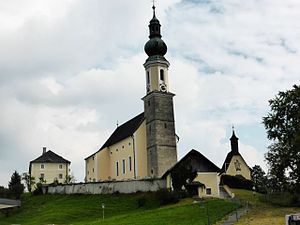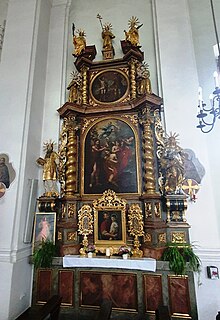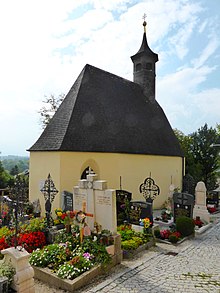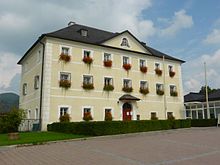Bergheim Parish Church
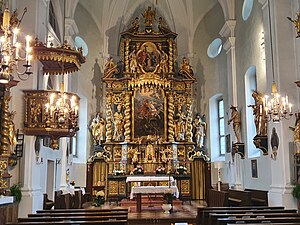
The Roman Catholic parish and deanery church of St. Georg is in the Bergheim community in the Salzburg-Umgebung district and is a listed building .
history
The church was already mentioned in the Notitia Arnonis from the 8th century. The patronage for hl. Georg could indicate that it was the former castle chapel of the Bergheimers . Whether the manor of the Bergheimer (the gesaezz zu Perkhaim ) actually stood here, however, is uncertain, as no older wall remains were found in the area during the renovation work in 1979/80 and 1990/91.
A church was first mentioned in a document in 927. Presumably the axis of this Gothic church was in the same direction as the current baroque building . In 1520 the church, the cemetery and the Laurentius chapel were consecrated here by the Chiemsee Bishop Berthold Pürstinger . In 1695 the church was demolished due to its dilapidation and rebuilt in the early baroque style by the builder Matthias Köllensperger . The author of the plan was probably Giovanni Gaspare Zuccalli , who under Archbishop Max Gandolf von Kuenburg had built the churches of St. Kajetan and St. Erhard in Salzburg and also the subsidiary churches of Söllheim and Hallwang that belonged to Bergheim.
In the early 11th century Bergheim was designated as the seat of the mother parish, which also included the branch churches in Fischach and Anthering . A first pastor is not mentioned by name until 1211. 1430 comes the St. Martin consecrated branch church in Hallwang . In 1642 Anthering and in 1787 Hallwang were spun off as vicariates and in 1790 a separate curate was formed in Elixhausen . Bergheim has been the seat of a deanery since 1812 , to which the parishes of Anif, Bergheim, Elixhausen, Eugendorf, Grödig, Großgmain, Hallwang, Niederalm, Siezenheim, St. Vitalis and Wals as well as the pastoral care offices Fürstenbrunn-Glanegg, Rif and Walserfeld belong.
Parish church
The choir faces northeast and follows the sunshine of the patronage ( St. George's Day , April 23). At the southern entrance there is a gravestone of the priest Wolfgang Hofer († 1565). The round north window is a Holy Spirit window created by Markus Ertl .
The church interior is a single-nave hall structure . The four bays of the nave are divided by wall pilasters . The choir ends in a round apse . The room is illuminated by square windows and ox eyes above . The wall structure continues with barrel vaults . The western end is formed by a double gallery with an organ.
Furnishing
The high altar was created by the Salzburg carpenter Lorenz Windpichler in 1705/1706. The altarpiece shows a depiction of Saint George fighting the dragon, which is here a symbol of evil. The excerpt above shows the coronation of Mary . Both pictures were painted by Johann Friedrich Pereth in 1704 . In addition to the winding columns, the figures of St. Judas Thaddäus , Rupert , Petrus and Johannes Nepomuk . On the altar there are also representations of St. Joseph , John the Evangelist , St. Barbara and Catherine of Alexandria . The Archangel Michael is depicted at the top of the altar .
The pulpit was made by Georg Michler in 1697. The decoration comes from Simeon Fries and shows Christ as Salvator mundi and the four evangelists . At the bottom of the pulpit is a pomegranate symbolizing the passion of Christ.
The two side altars are by Lorenz Windpichler from 1707.
On the left side of the church is the so-called cross altar . The figurative decoration comes from Simeon Fries. The altarpiece dates from around 1704. The Passau Maria Hilf picture is on the cafeteria . On the altar there are also the martyrs Stephanus and Laurentius as well as the martyrs hll. Appolonia and Agatha . About this are St. Scholastica and the founder of the monastery Ottilia from Alsace are shown. At the top is St. Margareta depicted.
On the right side of the church is the so-called Baptism Christ altar . The main picture shows the baptism of Christ by John the Baptist . On the round extract are Roman soldiers and the two martyrs Sebastian and Florian . The statue decoration consists of St. Zacharias and St. Elisabeth . About it are Anthony of Padua and Francis of Assisi and furthermore St. Charles Borromeo . There is a picture of St. Joseph with the boy Jesus; this comes from the Tyrolean painter Toni Kirchmayr from 1940.
organ
The first documented organ was "bought up from Burghausen" in 1704 . In 1859, Johann Nepomuk Carl Mauracher from Braunau am Inn built a new organ with eight registers , which was converted by Matthäus Mauracher in 1867 and an additional wind chest for five voices was added. There were two pedal stops and three stops for a second manual on this. Johann Joseph Kliebenschädl approved the organ on June 13, 1867.
In 1968, an instrument with mechanical slide chests and a free-standing console was built into the case from 1859 by the organ builder Dreher and Reinisch .
In 2017 the organ building company Johannes Klais created a new organ for Bergheim. This instrument has 28 stops on two manuals and a pedal. The case was returned to its original condition from 1859 and restored. The positive is housed in two new organ cases, which are placed on the wall to the side of the pedal housing and have a historicizing design. The organ dedication took Archbishop Franz Lackner before October 15, 2017th
- Disposition as on the registration plates
|
|
|
||||||||||||||||||||||||||||||||||||||||||||||||||||||||||||||||||||||||||||||||||||||||||||||||||||
- Coupling : II / I, II / I sub-octave coupling, I / P, II / P, II / P super-octave coupling
- Temperature control : Bach waiter
- Tuning tone : a 1 = 440 Hz at 15 ° C
Remarks
- ↑ Originally in honor of em. Pastor Felix Konigsberg with FELIX FLÖTEN 8 ' labeled.
- ↑ Exit tremulant.
- ↑ from c 0 , floating to SALICIONAL 8 ′, 40% tin.
- ↑ Exit tremulant.
- ↑ Extension from SUBBASS 16 ′, wood.
- ↑ Extension from OCTAVBASS 8 ′, 75% tin.
- ↑ full cup length, C – H wooden cup, from c 0 metal cup , 70% tin.
Laurentius Chapel
The Laurentius Chapel was consecrated in 1520. It is a single-nave room with a parallel ribbed vault and a 3/8 end. The high baroque altarpiece from the early 17th century depicts the martyr Laurentius . This chapel has served as Bergheim's war memorial since 1950.
Dechanthof
The rectory is a three-storey baroque building, the core of which dates from the 16th century. The facade and roof structure were rebuilt in 1760. In 1972 the inside of the building was rebuilt. The adjacent parish center was built in 1998 and inaugurated in 1999 by Auxiliary Bishop Jakob Mayr .
literature
- Friederike Zaisberger & Walter Schlegel : Castles and palaces in Salzburg. Flachgau and Tennengau . Birch series, Vienna 1992, ISBN 3-85326-957-5 .
- Catholic Parish Office Bergheim (Ed.): Parish Church of St. Georg in Bergheim. Verlag St. Peter - Erzabtei St. Peter: Salzburg 2012.
- Lukas Wegleiter / Ursula Schmalzl / Felix Königsberger / Hannes Taferner: New organ for Bergheim . In: Dekanatspfarramt Bergheim (ed.): The commemorative publication for the new Klais organ . Neumarkt am Wallersee 2017.
Web links
Individual evidence
- ↑ Friederike Zaisberger & Walter Schlegel, 1992, p. 28.
- ^ Alfons Kleiner: Beretti, Johann Friedrich. In: Artisti Italiani in Austria, University of Innsbruck, 2004
- ↑ Heribert Metzger : On the fortunes of the organs in Bergheim . (Excerpt from holdings in the archives of the Archdiocese of Salzburg , holdings 5.14, magazine 5). In: Lukas Wegleiter / Ursula Schmalzl / Felix Königsberger / Hannes Taferner: New organ for Bergheim . Ed .: Deanery Parish Office Bergheim. Neumarkt am Wallersee 2017. , p. 33.
- ↑ digitized version
- ↑ Information about the instrument and its disposition on the website of the organ building company Klais
Coordinates: 47 ° 50 '24.4 " N , 13 ° 1' 27.1" E
